|
SplashID provides quick and easy access to all of your personal identification
information, including usernames, passwords, credit cards, PINs, calling
card numbers, frequent flyer numbers, insurance info and more. Data
is stored in a secure, encrypted, password protected format.
Run the Installer and follow the on screen instructions. The installer
installs the following files:
- SplashID Desktop -- A desktop application (for Mac and Windows)
used to view and edit information on the desktop.
- SplashID User Guide -- This User Guide.
When you launch SplashID you will be prompted to enter a registration
code or to run in Trial mode. You may run the software for 30-days in
full-functioning Trial mode. The Trial software and Registered software
are identical. Once the trial period ends you must purchase and enter
a registration code to continue using the software. You do not need
to re-install the software. Simply enter a registration code and your
Trial version will be converted into a Registered version and all your
data will remain intact.
Quick Start
- Launch SplashID and several sample records will
be displayed.
- Click New to create a new record. In the Edit View
select a Type, such as Credit Card or Web
Login, and you will see the Field Labels
change accordingly.
- Click Done when you are finished entering the information for the
new record and you are returned to the List View.
- It is recommended you set a password to protect your data, which
you can do by selecting Set Password from the File menu. Make sure
you can remember this password, because it cannot be removed or reset
without deleting your data.
When you launch SplashID you are presented with the List View, which
displays a list of your items. Items are records of information, like
a credit card number and expiration date; or a username and password
for a web-site. There are two other useful views, Panel View and Tree
View, which you can select with the view buttons toward the top of
the window.
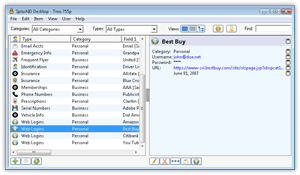
List View
|
SplashID Desktop has some great features
features:
- 3 Record Views -- Use the View buttons
to select from the traditional List View, or the new Panel
and Tree Views. Select a record from the List to display
the details in the Detail Pane on the right.
- Web Auto-Fill -- For Web Logins, click the globe
button or right click and select Auto-Fill to open Internet
Explorer to the selected URL and fill in the login info with
your data. See Web Auto-Fill for
more info. Or you may simply click on a URL or email address
in the preview pane to launch your web browser or email client.
- Database Sync -- You may select multiple
databases to synchronize with on the desktop, so you can
share data with other users, even across a network. See Database
Sync for more info.
- Types -- Use the Type menu on the top left to filter
the view by type, such as Credit Cards or Web Logins. All
Types are displayed by default, but you may restrict the
list to only display items assigned to a specific Types (see Categories
and Types).
- Categories -- Use the Category menu on the top right
to filter the view by Category, such as Business or Personal.
All categories are displayed by default, but you may restrict
the list to only display items assigned to a specific Category
(see Categories and Types).
|
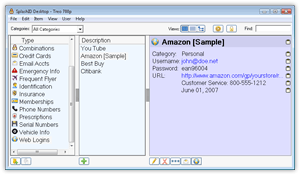
Panel View |
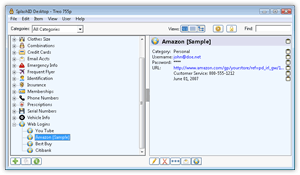
Tree View |
- Sorting -- click the column header to sort by that column.
click again to reverse sort.
- Resize columns -- You may resize a column by dragging the
left/right edges of the column header.
- Mask -- click the Mask button to show/hide masked fields.
- Click-able URLs -- You may click on a URL in the preview
pane to launch your web browser or email client.
- Copy field -- You may click the clipboard icon
 next
to a field in the preview pane to copy that field to the clipboard.
You may then paste this field into another application (e.g., copying
and pasting the password field from SplashID into a web browser).
Note: You may also type Control-1 through Control-7 to copy fields
1 through 9 to the clipboard. next
to a field in the preview pane to copy that field to the clipboard.
You may then paste this field into another application (e.g., copying
and pasting the password field from SplashID into a web browser).
Note: You may also type Control-1 through Control-7 to copy fields
1 through 9 to the clipboard.
Buttons
There are buttons scattered around the SplashID Desktop window, situated
by proximity to where they are to be used:
   -- Views:
Switch between Panel View, List View, and Tree View, respectively. -- Views:
Switch between Panel View, List View, and Tree View, respectively.
|
 -- Options:
Opens the Options dialog (below). -- Options:
Opens the Options dialog (below).
|
 -- Lock
Now : Locks SplashID immediately and requires a password
to open the data again. -- Lock
Now : Locks SplashID immediately and requires a password
to open the data again.
|
 -- New
Type: Opens the Edit Type Dialog for a new Record
Type. Available in Panel View only. -- New
Type: Opens the Edit Type Dialog for a new Record
Type. Available in Panel View only.
|
 -- Duplicate
Record: Opens the Edit Record Dialog for a duplicate
of the selected record. -- Duplicate
Record: Opens the Edit Record Dialog for a duplicate
of the selected record.
|
 -- Show
Details : Shows or hides the Record Detail Pane. -- Show
Details : Shows or hides the Record Detail Pane.
|
 -- New
Record: Opens the Edit Record Dialog for a new record. -- New
Record: Opens the Edit Record Dialog for a new record.
|
 -- Edit
Record: Opens the Edit Dialog for the selected record.
You can also double click the record. -- Edit
Record: Opens the Edit Dialog for the selected record.
You can also double click the record.
|
 -- Delete
Record: Deletes the selected record. You can also
hit the Delete key. -- Delete
Record: Deletes the selected record. You can also
hit the Delete key.
|
 -- Mask/Unmask:
Masks/Unmasks field data that has been specified as masked. See Masking. -- Mask/Unmask:
Masks/Unmasks field data that has been specified as masked. See Masking.
|
 -- Email
Records: Exports selected or all records to vID file,
then attaches it to a new email. -- Email
Records: Exports selected or all records to vID file,
then attaches it to a new email.
|
 -- Web
Auto-Fill : Launches Internet Explorer and fills in
record data for selected URL. More info. -- Web
Auto-Fill : Launches Internet Explorer and fills in
record data for selected URL. More info.
|
Options
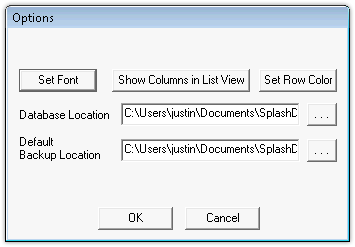
|
When you click the Options button  or
select Options from the Edit menu, you will see the dialog to
the left, with the following options: or
select Options from the Edit menu, you will see the dialog to
the left, with the following options:
- Set Font -- Select the Font type, style,
size and color from the fonts on your system.
- Show Columns in List View -- Select which
field data columns you would like to display in the List
View.
- Set Row Color -- Select the color of
the rows in List View, which will also be applied as the
background color in the Panel and Tree Views.
|
- Database Location -- Select a Custom database
location, including network locations. Note: You cannot select a
folder that already contains a SplashID database. See Database
Sync if you wish to share data.
- Auto Backup Location -- Change the location that
the automatic vID backup is saved to.
Web Auto-Fill
For Web Logins, you can have SplashID launch Internet Explorer and
automatically fill in the username and password fields for you. Please
take note of the following:
- Record type must be assigned to Web Logins.
- Username and password fields should be filled in.
- URL field must begin with either http:// or www. Find the correct
URL to get to the login screen on the selected website -- this is
often not the homepage.
- On Vista and/or Internet Explorer 7, you must disable Protected
Mode in:
- Tools > Internet Options > Security > Uncheck "Enable
Protected Mode"
- Click Apply, then restart Internet Explorer.
- This may not work with all sites.
Database Sync

New in SplashID 4, you can synchronize multiple database files manually,
at launch, and/or at exit. This is an advanced feature, not recommended
for beginner users. As always, it is recommended that you backup your
data with a vID export before trying out this feature, so you can revert
if you lose anything. Please Note: You can only sync
with other SplashID 4.x database files. At the time this User Guide
was written, that means only SplashID 4 for Palm OS users and SplashID
4 Desktop Only users.
To synchronize multiple database files:
- Click Add File and select a remote database to sync with. (Your
database does not need to be selected).
- Select the Sync Mode
- Synchronize -- Compares the databases and writes changes
to each.
- Current to Remote -- Overwrites remote data with current user
data.
- Remote to Current -- Overwrites current user data with remote
data.
- Set In Case of Conflict -- Current wins or Remote wins.
- Set Sync on Startup preference.
- Set Sync on Exit preference.
- Check the boxes for the databases you would like to sync.
- Select Sync Selected or Sync Now.
Edit Dialog
Open the Edit dialog for a given record by double-clicking a record.
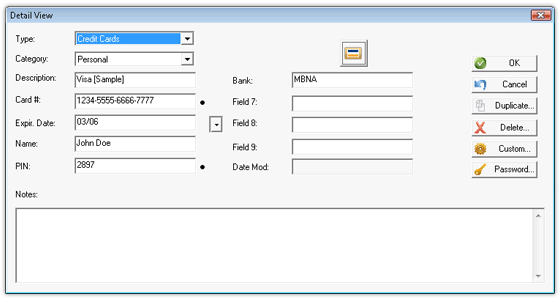
- Type
-- Select the Type from the Type menu. The Type will dictate the default
field labels, icons, and masking preferences for the record. See more
about Categories and Types.
- Category -- In the top right of the Edit View screen,
you can change the Category. It will default to the Category you were
displaying when you created the record. See more about Categories
and Types.
- Fields -- Enter your data according to the field
labels.
- Custom Field Labels -- You may assign Custom
Field Labels by clicking the Custom button.
- Masking -- A bullet appears to the right of any
field that is masked. You may Customize the field masking by clicking
the bullet or selecting Customize Field Labels from the Options Menu.
- Buttons --
- OK exits the record, saving any changes.
- Cancel exits the record, discarding any changes.
- Duplicate creates a copy of the record.
- Delete deletes the current record, after confirming
that is what you wish to do.
- Custom opens the Custom
Field Label dialog.
- Password opens the Automatic Password Generator
(below).
- Icon opens the icon selector.
Automatic Password Generator
To open the Automatic Password Generator, click the Password
button in the Edit Dialog.
To create a password:
- Set the Length.
- Check or Uncheck the pronounceable setting.
- Choose from the Character Sets one or more options of letters,
numbers, symbols, or a combinatory thereof.
- click Generate. click again until you get a suitable password.
- click OK when you have decided.
|
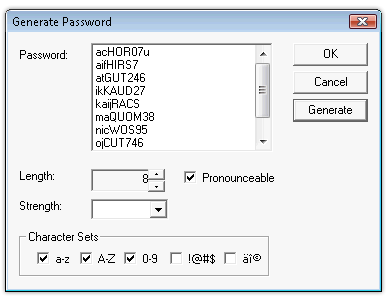 |
The difference between Categories and Types is best illustrated by
example. You may use Categories to separate your Business records from
your Personal records, while you use Types to separate your Credit Card
records from your Web Login records.
Categories act as filters for grouping related records. The two pre-defined
Categories are Business and Personal, though you may add more by choosing
Edit Categories from the Category menu.
Types act as templates, which define the structure for the items you
want to store in SplashID. You may define up to 9 custom field labels
and a default icon for each type, as well as specify the fields you
wish to mask. For example, you may create a type for Web Logins, which
includes custom field labels for username, password and URL, with a
globe icon, and the password field masked; and you may create a Type
for Credit Cards which includes custom field labels for credit card
number, expiration date and PIN, with a Visa icon, and the credit card
number and PIN masked.
- Edit Types -- Select Edit Types from the type menu to display
the Edit Types dialog. You may create an unlimited number of Types.
Several sample Types are provided, which you may edit or delete. Select
an existing type and click edit, or click New to create a new one. The
Define type dialog is displayed.
- Define Type -- Enter a name for the Type and up to 9 custom
field labels. The Mask checkbox specifies whether or not the data
in that field will be masked. And you may also specify a default icon
for the Type.
Custom Field Labels
Field Labels and masking are set by default when you define a Type.
You may change the Field Labels and masking, however, at the record
level by clicking the Field Label itself, or by choosing Customize
Fields from the Item Menu.
Masking
Fields that are Masked appear as four asterisks (****). You may show
or hide the masked data by clicking the Mask toggle on the upper right
corner of the screen.
If you wish to permanently mask or unmask a field, you can change its
mask setting in the Edit Type dialog or the Custom
Field Labels dialog.
You
may search for records in SplashID by typing in the Find box
(press Ctrl-F to jump there). All fields in all records in SplashID
will be searched and any matching records will appear in the results
below. You may then click an item to go to the Detail View for that
item.
You can secure your data in SplashID so that a password must be entered
to access the application. You will be required to enter the password
when launching SplashID. Once you set a password, SplashID encrypts
your data using Blowfish encryption to ensure data security.
- Setting a Password -- To set a password, select Set Password
from the File Menu. The Set Password dialog is displayed. Enter a
password in the New Password field, and verify the password by entering
it again in the Confirm field.
- Entering a Password -- You will be required to enter your
password each time you launch SplashID. You may enter the password
using Graffiti, or with one of the onscreen keyboards. You may toggle
between the alpha-numeric keyboard and the numeric keypad using the
abc/123 button on the top right of the password dialog. The numeric
keypad is suitable for entering a numeric password without a stylus,
using your fingers.
- Changing a Password -- To change a password, select Set Password
from the File Menu, enter your Old Password, then enter and confirm
the New Password.
- Removing a Password -- To remove a password, select Set Password
from the File Menu, enter your Old Password, then leave the New Password
and Confirm fields blank.
Auto-Lock -- Choose Auto-Lock from
the Options dialog to specify the period of inactivity that must elapse
before SplashID auto-locks. Once SplashID locks, you must enter your
password to open SplashID.
You can share information with other SplashID Desktop users by exporting
and importing your SplashID records. Records can be exported/imported
on the desktop in several formats:
SplashID vID
You may import and export SplashID records in SplashID Virtual ID
(vID) format, which allows you to export and import records in
a secure, encrypted format. vID files may be encrypted by assigning
a password when exporting. The recipient of the vID file may import
the data into their copy of SplashID Desktop by double-clicking
the file, or choosing Import/SplashID vID from the File Menu. If
a password was assigned to the file, the recipient must enter the
password in order to import the data.
vID files are a convenient way to share records with a coworker
or spouse by exporting a vID file, assigning a password (optional),
and then emailing the resulting vID file to the recipient. You can
even use the vID format as a backup mechanism by periodically exporting
a vID file and archiving it on a backup disk.
*New in SplashID 4* -- You can also use the Email button on the
SplashID desktop to export vID files and attach them to a new email
message.
CSV
You may also import and export SplashID records in CSV format. CSV
stands for Comma Separated Values, and is a common file format
readable by most spreadsheets, databases and word processors. If
you wish to import a CSV file, the data must be in the following
format:
Type, Custom 1, Custom 2, Custom 3, Custom 4, Custom 5, Custom 6,
Custom 7, Custom 8, Custom 9, Date Modified, Notes, Category
It is easy to create the above format in Excel by creating a spreadsheet
with 13 columns (as designated above) with one record per row. Then
save the file in CSV format.
Note: When importing data, if the type field is blank the record
will be placed in Unfiled. If there is a type name and it does not
match an existing type a new type will be created.
Automatic vID Backups
SplashID Desktop has an automatic backup feature which will allow
you to easily recover data in most cases. Whenever the data has been
changed, a backup is made each time you exit SplashID Desktop. A vID
export file is created (and encrypted with the same password you are
using in SplashID) and stored in:
My Documents\SplashData\SplashID\Backup\SplashID-_Standalone_.vid
If you later need to restore this data, simply double-click the .vid
file and you will be prompted for a password and the data will be imported
into SplashID Desktop.
You may change the location that this file is backed up to in SplashID
Desktop Options.
Manual vID Backups
You may also perform a manual backup of your data by selecting
Backup from the File menu. This will export your SplashID Database
in vID format to whatever location you select. You will be given the
option to set a password as well, which will encrypt the data and require
the password to restore it.
Restore
Select Restore from the File menu to restore a vID file that has
been backed up either automatically or manually as described above.
The password will remain the same for the application even if the password
for the backup file was different.
Desktop
The SplashID Desktop database file is automatically saved to the
SplashID directory on your hard drive each time you exit the application.
You may back up this file as an added precaution in case of a hard
drive failure. To restore the backup file simply copy it into the SplashID
directory. Then the next time you launch SplashID it will open the
file. This file is stored here:
My Documents\SplashData\SplashID\_Standalone_
You may change the location that this file is saved to in SplashID
desktop Options.
You can share information with other SplashID Desktop users by exporting
and importing your SplashID records. Records can be exported/imported
on the desktop in several formats:
SplashID vID
You may import and export SplashID records in SplashID Virtual ID
(vID) format, which allows you to export and import records in a secure,
encrypted format. vID files may be encrypted by assigning a password
when exporting. The recipient of the vID file may import the data
into their copy of SplashID Desktop by double-clicking the file, or
choosing Import/SplashID vID from the File Menu. If a password was
assigned to the file, the recipient must enter the password in order
to import the data.
vID files are a convenient way to share records with a coworker or
spouse by exporting a vID file, assigning a password (optional), and
then emailing the resulting vID file to the recipient. You can even
use the vID format as a backup mechanism by periodically exporting
a vID file and archiving it on a backup disk.
CSV
You may also import and export SplashID records in CSV format. CSV
stands for Comma Separated Values, and is a common file format readable
by most spreadsheets, databases and word processors. If you wish to
import a CSV file, the data must be in the following format:
Type, custom 1, custom 2, custom 3, custom 4, custom 5, custom 6,
Notes, Category
It is easy to create the above format in Excel by creating a spreadsheet
with 8 columns (as designated above) with one record per row. Then
save the file in CSV format.
Note: When importing data, if the type field is blank the record
will be placed in Unfiled. If there is a type name and it does not
match an existing type a new type will be created.
Automatic vID Backups
SplashID Desktop has an automatic backup feature which will allow
you to easily recover data in most cases. Whenever the data has been
changed, a backup is made each time you exit SplashID Desktop. A vID
export file is created (and encrypted with the same password you are
using in SplashID) and stored in:
My Documents\SplashData\SplashID\Backup\SplashID-_Standalone_.vid
If you later need to restore this data, simply double-click the .vid
file and you will be prompted for a password and the data will be imported
into SplashID Desktop.
Manual vID Backups
You may also perform a manual backup of your data by selecting Backup
from the File menu. This will export your SplashID Database in vID format
to whatever location you select. You will be given the option to set
a password as well, which will encrypt the data and require the password
to restore it.
Restore
Select Restore from the File menu to restore a vID file that has
been backed up either automatically or manually as described above.
The password will remain the same for the application even if the password
for the backup file was different.
The SplashID Desktop database file is automatically saved to the SplashID
directory on your hard drive each time you exit the application. You
may back up this file as an added precaution in case of a hard drive
failure. To restore the backup file simply copy it into the SplashID
directory. Then the next time you launch SplashID it will open the file.
This file is stored here:
My Documents\SplashData\SplashID\_Standalone_
You may change the location of the SplashID database file by selecting
Change Database Location from the File menu and selecting a different
directory. You may choose a local directory on your computer or a
network directory. |







